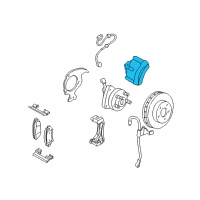< Back ×
My Vehicle Change Vehicle
2005 Buick LeSabre
< Back to View All
Brake Pads, Discs & Calipers
- Department
- Installation Hardware Included
- Pads Included
- Series
- Brands
- Prices
OEM (Genuine) 2005 Buick LeSabre Caliper
PartNumber: 18046196 Product Specifications
Product Specifications- Notes: W/16" Wheel
- Location: Driver Side
- Other Names: Caliper
- Item Dimensions: 9.5 x 8.3 x 6.1 inches
- Item Weight: 9.60 Pounds
- Fitment Type: Direct Replacement
- Replaces: 18029818
- Part Description: 2005 Buick LeSabre Caliper
Vehicle Fitment- 2005 Buick LeSabre | Custom, Limited | 6 Cyl 3.8 L GAS
$150.64 MSRP:$284.26You Save: $133.62 (48%)

Centric® Remanufactured Semi-Loaded Rear Passenger Side Brake Caliper for 2005 Buick LeSabre
PartNumber: 141.62563Product Specifications- UPC: 805890157779
- Part Description: 2005 Buick LeSabre Remanufactured Semi-Loaded Rear Passenger Side Brake Caliper
Vehicle Fitment- 2005 Buick LeSabre | All Trims | All Engines
$42.30

Centric® Remanufactured Semi-Loaded Rear Driver Side Brake Caliper for 2005 Buick LeSabre
PartNumber: 141.62564Product Specifications- UPC: 805890157786
- Part Description: 2005 Buick LeSabre Remanufactured Semi-Loaded Rear Driver Side Brake Caliper
Vehicle Fitment- 2005 Buick LeSabre | All Trims | All Engines
$42.30

Cardone Reman® Remanufactured Unloaded Caliper for 2005 Buick LeSabre
PartNumber: 18-4719Product Specifications- Notes: with Metal Piston;Installation Hardware Included;Supplied without Mounting Bracket
- Bleeder Size: M10x1.5
- Bracket: without Mounting Bracket
- Caliper Color: Gray
- Caliper Configuration: Unloaded
- Inlet Port Size: M10x1.5
- Material: Iron
- Piston Material: Steel
- Piston Quantity: 1-Piston
- Piston Size: 38mm (1.5")
- Part Description: 2005 Buick LeSabre Remanufactured Unloaded Caliper
Vehicle Fitment- 2005 Buick LeSabre | All Trims | All Engines
$59.12

Centric® Remanufactured Semi-Loaded Front Passenger Side Brake Caliper for 2005 Buick LeSabre
PartNumber: 141.62119Product Specifications- Notes: 15" Wheels
- UPC: 805890124979
- Part Description: 2005 Buick LeSabre Remanufactured Semi-Loaded Front Passenger Side Brake Caliper
Vehicle Fitment- 2005 Buick LeSabre | All Trims | All Engines
$29.77

Cardone Reman® Remanufactured Unloaded Caliper w/Bracket for 2005 Buick LeSabre
PartNumber: 18-B4718BProduct Specifications- Notes: Installation Hardware Included;with Metal Piston;Supplied with Mounting Bracket
- Bleeder Size: M10x1.5
- Bracket: With Mounting Bracket
- Caliper Color: Gray
- Caliper Configuration: Unloaded
- Inlet Port Size: M10x1.5
- Material: Iron
- Piston Material: Steel
- Piston Quantity: 1-Piston
- Piston Size: 38mm (1.5")
- Part Description: 2005 Buick LeSabre Remanufactured Unloaded Caliper w/Bracket
Vehicle Fitment- 2005 Buick LeSabre | All Trims | All Engines
$51.19

Centric® Remanufactured Semi-Loaded Front Driver Side Brake Caliper for 2005 Buick LeSabre
PartNumber: 141.62120Product Specifications- Notes: 15" Wheels
- UPC: 805890124986
- Part Description: 2005 Buick LeSabre Remanufactured Semi-Loaded Front Driver Side Brake Caliper
Vehicle Fitment- 2005 Buick LeSabre | All Trims | All Engines
$29.77

Cardone Reman® Remanufactured Unloaded Caliper w/Bracket for 2005 Buick LeSabre
PartNumber: 18-B4719BProduct Specifications- Notes: Supplied with Mounting Bracket;Installation Hardware Included;with Metal Piston
- Bleeder Size: M10x1.5
- Bracket: With Mounting Bracket
- Caliper Color: Gray
- Caliper Configuration: Unloaded
- Inlet Port Size: M10x1.5
- Material: Iron
- Piston Material: Steel
- Piston Quantity: 1-Piston
- Piston Size: 38mm (1.5")
- Part Description: 2005 Buick LeSabre Remanufactured Unloaded Caliper w/Bracket
Vehicle Fitment- 2005 Buick LeSabre | All Trims | All Engines
$51.19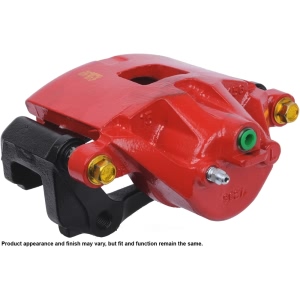

Cardone Reman® Remanufactured Unloaded Color Coated Caliper for 2005 Buick LeSabre
PartNumber: 18-4638XRProduct Specifications- Notes: Installation Hardware Included;with 15" Wheels;Powder Coated Red;with Metal Piston
- Bleeder Size: M10x1.5
- Bracket: With Mounting Bracket
- Caliper Color: Red/Black
- Caliper Configuration: Unloaded
- Inlet Port Size: M10x1.5
- Material: Iron
- Piston Material: Steel
- Piston Quantity: 1-Piston
- Piston Size: 63.5mm (2.5")
- Part Description: 2005 Buick LeSabre Remanufactured Unloaded Color Coated Caliper
Vehicle Fitment- 2005 Buick LeSabre | All Trims | All Engines
$47.30

Cardone Reman® Remanufactured Unloaded Color Coated Caliper for 2005 Buick LeSabre
PartNumber: 18-4639XBProduct Specifications- Notes: Installation Hardware Included;with Metal Piston;with 15" Wheels;Powder Coated Black
- Bleeder Size: M10x1.5
- Bracket: With Mounting Bracket
- Caliper Color: Black
- Caliper Configuration: Unloaded
- Inlet Port Size: M10x1.5
- Material: Iron
- Piston Material: Steel
- Piston Quantity: 1-Piston
- Piston Size: 63.5mm (2.5")
- Part Description: 2005 Buick LeSabre Remanufactured Unloaded Color Coated Caliper
Vehicle Fitment- 2005 Buick LeSabre | All Trims | All Engines
$47.30

Cardone Reman® Remanufactured Unloaded Caliper for 2005 Buick LeSabre
PartNumber: 18-4638Product Specifications- Notes: Supplied without Mounting Bracket;Installation Hardware Included;with Metal Piston
- Bleeder Size: M10x1.5
- Bracket: without Mounting Bracket
- Caliper Color: Gray
- Caliper Configuration: Unloaded
- Inlet Port Size: M10x1.5
- Material: Iron
- Piston Material: Steel
- Piston Quantity: 1-Piston
- Piston Size: 63.5mm (2.5")
- Part Description: 2005 Buick LeSabre Remanufactured Unloaded Caliper
Vehicle Fitment- 2005 Buick LeSabre | All Trims | All Engines
$37.91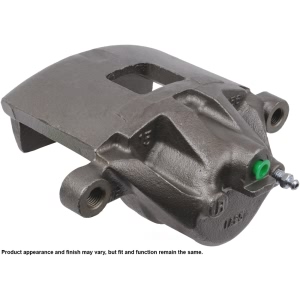

Cardone Reman® Remanufactured Unloaded Caliper for 2005 Buick LeSabre
PartNumber: 18-4639Product Specifications- Notes: Installation Hardware Included;with Metal Piston;Supplied without Mounting Bracket
- Bleeder Size: M10x1.5
- Bracket: without Mounting Bracket
- Caliper Color: Gray
- Caliper Configuration: Unloaded
- Inlet Port Size: M10x1.5
- Material: Iron
- Piston Material: Steel
- Piston Quantity: 1-Piston
- Piston Size: 63.5mm (2.5")
- Part Description: 2005 Buick LeSabre Remanufactured Unloaded Caliper
Vehicle Fitment- 2005 Buick LeSabre | All Trims | All Engines
$37.91

Cardone Reman® Remanufactured Unloaded Caliper w/Bracket for 2005 Buick LeSabre
PartNumber: 18-B4638BProduct Specifications- Notes: Installation Hardware Included;Supplied with Mounting Bracket;with Metal Piston;with 16" Wheels
- Bleeder Size: M10x1.5
- Bracket: With Mounting Bracket
- Caliper Color: Gray
- Caliper Configuration: Unloaded
- Inlet Port Size: M10x1.5
- Material: Iron
- Piston Material: Steel
- Piston Quantity: 1-Piston
- Piston Size: 63.5mm (2.5")
- Part Description: 2005 Buick LeSabre Remanufactured Unloaded Caliper w/Bracket
Vehicle Fitment- 2005 Buick LeSabre | All Trims | All Engines
$35.43

Cardone Reman® Remanufactured Unloaded Caliper w/Bracket for 2005 Buick LeSabre
PartNumber: 18-B4639BProduct Specifications- Notes: Installation Hardware Included;with 16" Wheels;with Metal Piston;Supplied with Mounting Bracket
- Bleeder Size: M10x1.5
- Bracket: With Mounting Bracket
- Caliper Color: Gray
- Caliper Configuration: Unloaded
- Inlet Port Size: M10x1.5
- Material: Iron
- Piston Material: Steel
- Piston Quantity: 1-Piston
- Piston Size: 63.5mm (2.5")
- Part Description: 2005 Buick LeSabre Remanufactured Unloaded Caliper w/Bracket
Vehicle Fitment- 2005 Buick LeSabre | All Trims | All Engines
$35.43

Cardone Reman® Remanufactured Unloaded Caliper w/Bracket for 2005 Buick LeSabre
PartNumber: 18-B4638Product Specifications- Notes: with 15" Wheels;with Metal Piston;Installation Hardware Included;Supplied with Standard Boots;Supplied with Mounting Bracket
- Bleeder Size: M10x1.5
- Boots: Rubber
- Bracket: With Mounting Bracket
- Caliper Color: Gray
- Caliper Configuration: Unloaded
- Inlet Port Size: M10x1.5
- Material: Iron
- Piston Material: Steel
- Piston Quantity: 1-Piston
- Piston Size: 63.5mm (2.5")
- Part Description: 2005 Buick LeSabre Remanufactured Unloaded Caliper w/Bracket
Vehicle Fitment- 2005 Buick LeSabre | All Trims | All Engines
$34.40

Cardone Reman® Remanufactured Unloaded Caliper w/Bracket for 2005 Buick LeSabre
PartNumber: 18-B4639Product Specifications- Notes: with 15" Wheels;Supplied with Standard Boots;Supplied with Mounting Bracket;Installation Hardware Included;with Metal Piston
- Bleeder Size: M10x1.5
- Boots: Rubber
- Bracket: With Mounting Bracket
- Caliper Color: Gray
- Caliper Configuration: Unloaded
- Inlet Port Size: M10x1.5
- Material: Iron
- Piston Material: Steel
- Piston Quantity: 1-Piston
- Piston Size: 63.5mm (2.5")
- Part Description: 2005 Buick LeSabre Remanufactured Unloaded Caliper w/Bracket
Vehicle Fitment- 2005 Buick LeSabre | All Trims | All Engines
$34.40

Centric® Remanufactured Semi-Loaded Front Passenger Side Brake Caliper for 2005 Buick LeSabre
PartNumber: 141.62145Product Specifications- Notes: 16" Wheels
- UPC: 805890303541
- Part Description: 2005 Buick LeSabre Remanufactured Semi-Loaded Front Passenger Side Brake Caliper
Vehicle Fitment- 2005 Buick LeSabre | All Trims | All Engines
$29.44

Centric® Remanufactured Semi-Loaded Front Driver Side Brake Caliper for 2005 Buick LeSabre
PartNumber: 141.62146Product Specifications- Notes: 16" Wheels
- UPC: 805890303831
- Part Description: 2005 Buick LeSabre Remanufactured Semi-Loaded Front Driver Side Brake Caliper
Vehicle Fitment- 2005 Buick LeSabre | All Trims | All Engines
$29.44

Centric® Posi Quiet™ Loaded Front Passenger Side Brake Caliper for 2005 Buick LeSabre
PartNumber: 142.62119Product Specifications- Notes: 15" Wheels
- UPC: 805890350545
- Part Description: 2005 Buick LeSabre Posi Quiet™ Loaded Front Passenger Side Brake Caliper
Vehicle Fitment- 2005 Buick LeSabre | All Trims | All Engines
$36.33

Centric® Posi Quiet™ Loaded Caliper for 2005 Buick LeSabre
PartNumber: 142.62563Product Specifications- UPC: 805890402725
- Part Description: 2005 Buick LeSabre Posi Quiet™ Loaded Caliper
Vehicle Fitment- 2005 Buick LeSabre | All Trims | All Engines
$54.02

Cardone Reman® Remanufactured Unloaded Caliper for 2005 Buick LeSabre
PartNumber: 18-4718Product Specifications- Notes: Supplied without Mounting Bracket;with Metal Piston;Installation Hardware Included
- Bleeder Size: M10x1.5
- Bracket: without Mounting Bracket
- Caliper Color: Gray
- Caliper Configuration: Unloaded
- Inlet Port Size: M10x1.5
- Material: Iron
- Piston Material: Steel
- Piston Quantity: 1-Piston
- Piston Size: 38mm (1.5")
- Part Description: 2005 Buick LeSabre Remanufactured Unloaded Caliper
Vehicle Fitment- 2005 Buick LeSabre | All Trims | All Engines
OEM (Genuine) 2005 Buick LeSabre Caliper
PartNumber: 18046201 Product Specifications
Product Specifications- Notes: W/15" Wheel
- Location: Passenger Side
- Other Names: Caliper
- Item Dimensions: 8.0 x 8.9 x 6.6 inches
- Item Weight: 10.90 Pounds
- Fitment Type: Direct Replacement
- Replaces: 18024957
- Part Description: 2005 Buick LeSabre Caliper
Vehicle Fitment- 2005 Buick LeSabre | Custom, Limited | 6 Cyl 3.8 L GAS


Cardone Reman® Remanufactured Unloaded Color Coated Caliper for 2005 Buick LeSabre
PartNumber: 18-4638XYProduct Specifications- Notes: Installation Hardware Included;with Metal Piston;with 15" Wheels;Powder Coated Yellow
- Bleeder Size: M10x1.5
- Bracket: With Mounting Bracket
- Caliper Color: Yellow/Black
- Caliper Configuration: Unloaded
- Inlet Port Size: M10x1.5
- Material: Iron
- Piston Material: Steel
- Piston Quantity: 1-Piston
- Piston Size: 63.5mm (2.5")
- Part Description: 2005 Buick LeSabre Remanufactured Unloaded Color Coated Caliper
Vehicle Fitment- 2005 Buick LeSabre | All Trims | All Engines
OEM (Genuine) 2005 Buick LeSabre Caliper Asm, Rear Brake
PartNumber: 89047652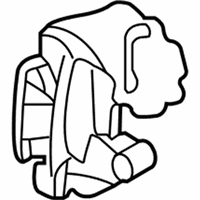 Product Specifications
Product Specifications- Location: Passenger Side
- Other Names: Caliper
- Item Dimensions: 9.8 x 7.5 x 5.4 inches
- Item Weight: 6.30 Pounds
- Fitment Type: Direct Replacement
- Replaces: 18042414
- Part Description: 2005 Buick LeSabre Caliper Asm, Rear Brake
Vehicle Fitment- 2005 Buick LeSabre | Custom, Limited | 6 Cyl 3.8 L GAS
OEM (Genuine) 2005 Buick LeSabre Caliper Asm, Rear Brake
PartNumber: 89047651 Product Specifications
Product Specifications- Location: Driver Side
- Other Names: Caliper
- Item Dimensions: 9.4 x 7.5 x 5.3 inches
- Item Weight: 6.70 Pounds
- Fitment Type: Direct Replacement
- Replaces: 18042413
- Part Description: 2005 Buick LeSabre Caliper Asm, Rear Brake
Vehicle Fitment- 2005 Buick LeSabre | Custom, Limited | 6 Cyl 3.8 L GAS
OEM (Genuine) 2005 Buick LeSabre Caliper Asm, Rear Brake(LH) *Red
PartNumber: 89047796 Product Specifications
Product Specifications- Notes: Bonneville, Lesabre; Left; W/Gxp Model
- Other Names: Caliper
- Item Dimensions: 12.9 x 10.4 x 5.8 inches
- Item Weight: 6.30 Pounds
- Fitment Type: Direct Replacement
- Part Description: 2005 Buick LeSabre Caliper Asm, Rear Brake(LH) *Red
Vehicle Fitment- 2005 Buick LeSabre | Custom, Limited | 6 Cyl 3.8 L GAS
OEM (Genuine) 2005 Buick LeSabre Caliper Asm, Rear Brake(RH) *Red
PartNumber: 89047797 Product Specifications
Product Specifications- Notes: Bonneville, Lesabre; Right; W/Gxp Model
- Other Names: Caliper
- Item Dimensions: 12.8 x 10.1 x 5.8 inches
- Item Weight: 6.30 Pounds
- Fitment Type: Direct Replacement
- Part Description: 2005 Buick LeSabre Caliper Asm, Rear Brake(RH) *Red
Vehicle Fitment- 2005 Buick LeSabre | Custom, Limited | 6 Cyl 3.8 L GAS
OEM (Genuine) 2005 Buick LeSabre Caliper Asm, Front Brake (Service)
PartNumber: 18046197 Product Specifications
Product Specifications- Notes: W/16" Wheel
- Location: Passenger Side
- Other Names: Caliper
- Item Dimensions: 8.2 x 9.2 x 6.5 inches
- Item Weight: 10.10 Pounds
- Fitment Type: Direct Replacement
- Replaces: 18029819
- Part Description: 2005 Buick LeSabre Caliper Asm, Front Brake (Service)
Vehicle Fitment- 2005 Buick LeSabre | Custom, Limited | 6 Cyl 3.8 L GAS
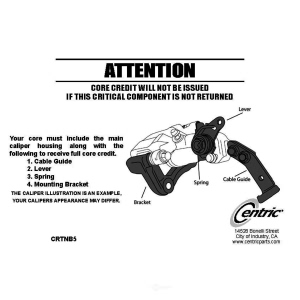

Centric® Semi-Loaded Brake Caliper for 2005 Buick LeSabre
PartNumber: 141.62541Product Specifications- UPC: 805890125396
- Part Description: 2005 Buick LeSabre Semi-Loaded Brake Caliper
Vehicle Fitment- 2005 Buick LeSabre | All Trims | All Engines
OEM (Genuine) 2005 Buick LeSabre Caliper, Front Brake
PartNumber: 18046200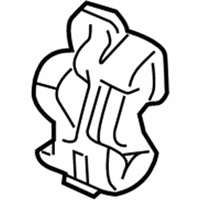 Product Specifications
Product Specifications- Notes: W/15" Wheel
- Location: Driver Side
- Other Names: Caliper
- Item Dimensions: 8.2 x 9.2 x 6.6 inches
- Item Weight: 10.10 Pounds
- Fitment Type: Direct Replacement
- Replaces: 18024956
- Part Description: 2005 Buick LeSabre Caliper, Front Brake
Vehicle Fitment- 2005 Buick LeSabre | Custom, Limited | 6 Cyl 3.8 L GAS
1-30 of 36 Results
< Previous
12
Next >FAQ for Brake Caliper Repair
Q: What should be cautioned in installing the Rear Brake Caliper?
A:
You should lubricate the brake caliper pin bolts with a thin coat of high-temperature silicone lube, install the brake caliper to the upper caliper pin bolt and rotate the brake caliper down over the brake pads into the brake caliper bracket.
By Bob
GM Specialist
29/10/2022Q: What should be noticed in removing the Front Brake Caliper?
A:
If the brake fluid level is midway between the maximum-full point and the minimum allowable level, no brake fluid needs to be removed from the reservoir before proceeding. If the brake fluid level is higher than midway between the maximum-full point and the minimum allowable level, you should remove the brake fluid to the midway point before proceeding.
By Bob
GM Specialist
29/10/2022Q: What should be cautioned in the Rear Brake Caliper overhaul?
A:
If the brake caliper was leaking brake fluid from the REAR of the caliper past the integral park brake actuator shaft seal, you should replace the brake caliper assembly. The park brake integral mechanism contains a non-serviceable seal which may be allowing brake fluid to leak past it and into the non-serviceable integral park brake mechanism. The park brake lever, lever return spring, and actuator shaft seal are the only components of the integral park brake mechanism that can be removed or replaced. You can not disassemble the integral park brake mechanism. If the integral park brake mechanism was not operating properly binding or seized, you should replace the brake caliper assembly.
By Bob
GM Specialist
29/10/2022Q: What should be noticed when replacing the Brake Caliper Overhaul-Front?
A:
You can not place your fingers in front of the piston to catch or protect the piston while applying compressed air. This could result in serious injury. You should use clean cloths to pad the interior of the caliper housing during piston removal and use just enough air to ease the pistons out of the bores. If the pistons are blown out, even with the padding provided, it may be damaged.
By Bob
GM Specialist
29/10/2022Q: What should be cautioned in using the Brake Caliper?
A:
You should use clean cloths to pad the interior of the caliper housing during piston removal and use just enough air to ease the pistons out of the bores. If the pistons are blown out, even with the padding provided, it may be damaged. The caliper bracket bolt threads and the threaded holes of the caliper bracket must be free of thread locker residue and debris before re-application of the thread locker to ensure proper adhesion and fastener retention. If reusing the old caliper bracket bolts, you should apply thread locker GM P/N 12345493, (Canadian P/N 10953488), or equivalent to two-thirds of the threaded length of the fastener and ensure that there are no gaps in the thread locker along the length of the filled area of the fastener.
By Bob
GM Specialist
29/10/2022Q: What should be noticed in removing the Rear Brake Caliper?
A:
When using a large C-clamp to compress a caliper piston into a caliper bore of a caliper equipped with an integral park brake mechanism, you can not exceed more than 1 mm (0.039 in) of piston travel. Exceeding this amount of piston travel will cause damage to the internal adjusting mechanism and/or the integral park brake mechanism.
By Bob
GM Specialist
29/10/2022Q: What should be noticed in removing the Front Brake Caliper Bracket?
A:
You should support the brake caliper with heavy mechanic's wire, or equivalent, whenever it is separated from its mount and the hydraulic flexible brake hose is still connected.
By Bob
GM Specialist
29/10/2022Q: What should be cautioned in installing the front Brake Caliper?
A:
If reusing the brake caliper pin bolts, you should wipe the old grease from the brake caliper pin bolts with a clean shop towel. You can not apply lubricant to the brake pad hardware.
By Bob
GM Specialist
29/10/2022Q: What should be cautioned about in installing the Brake Caliper Bracket-Front?
A:
If reusing the old caliper bracket bolts, apply thread locker GM P/N 12345493, (Canadian P/N 10953488), or equivalent to two-thirds of the threaded length of the fastener. You should ensure that there are no gaps in the thread locker along the length of the filled area of the fastener and allow the thread locker to cure approximately ten minutes before installation.
By Bob
GM Specialist
29/10/2022See more FAQs (4)


